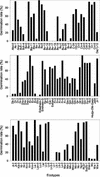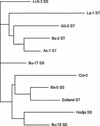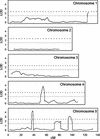Genetic architecture of NaCl tolerance in Arabidopsis
- PMID: 12376659
- PMCID: PMC166621
- DOI: 10.1104/pp.006536
Genetic architecture of NaCl tolerance in Arabidopsis
Abstract
The little success of breeding approaches toward the improvement of salt tolerance in crop species is thought to be attributable to the quantitative nature of most, if not all the processes implicated. Hence, the identification of some of the quantitative trait loci (QTL) that contribute to natural variation in salt tolerance should be instrumental in eventually manipulating the perception of salinity and the corresponding responses. A good choice to reach this goal is the plant model system Arabidopsis, whose complete genome sequence is now available. Aiming to analyze natural variability in salt tolerance, we have compared the ability of 102 wild-type races (named ecotypes or accessions) of Arabidopsis to germinate on 250 mM NaCl, finding a wide range of variation among them. Accessions displaying extremely different responses to NaCl were intercrossed, and the phenotypes found in their F(2) progenies suggested that natural variation in NaCl tolerance during germination was under polygenic controls. Genetic distances calculated on the basis of variations in repeat number at 22 microsatellites, were analyzed in a group of either extremely salt-tolerant or extremely salt-sensitive accessions. We found that most but not all accessions with similar responses to NaCl are phylogenetically related. NaCl tolerance was also studied in 100 recombinant inbred lines derived from a cross between the Columbia-4 and Landsberg erecta accessions. We detected 11 QTL harboring naturally occurring alleles that contribute to natural variation in NaCl tolerance in Arabidopsis, six at the germination and five at the vegetative growth stages, respectively. At least five of these QTL are likely to represent loci not yet described by their relationship with salt stress.
Figures





Similar articles
-
Mapping salinity tolerance during Arabidopsis thaliana germination and seedling growth.PLoS One. 2011;6(8):e22832. doi: 10.1371/journal.pone.0022832. Epub 2011 Aug 12. PLoS One. 2011. PMID: 21857956 Free PMC article.
-
Germination variation in Arabidopsis thaliana accessions under moderate osmotic and salt stresses.Ann Bot. 2010 Nov;106(5):833-42. doi: 10.1093/aob/mcq179. Epub 2010 Sep 22. Ann Bot. 2010. PMID: 20861274 Free PMC article.
-
Genetic analysis of natural variations in the architecture of Arabidopsis thaliana vegetative leaves.Genetics. 2002 Oct;162(2):893-915. doi: 10.1093/genetics/162.2.893. Genetics. 2002. PMID: 12399398 Free PMC article.
-
Natural genetic variation of root system architecture from Arabidopsis to Brachypodium: towards adaptive value.Philos Trans R Soc Lond B Biol Sci. 2012 Jun 5;367(1595):1552-8. doi: 10.1098/rstb.2011.0237. Philos Trans R Soc Lond B Biol Sci. 2012. PMID: 22527398 Free PMC article. Review.
-
Endopolyploidy as a potential alternative adaptive strategy for Arabidopsis leaf size variation in response to UV-B.J Exp Bot. 2014 Jun;65(10):2757-66. doi: 10.1093/jxb/ert473. Epub 2014 Jan 27. J Exp Bot. 2014. PMID: 24470468 Free PMC article. Review.
Cited by
-
QTL mapping for salt tolerance and domestication-related traits in Vigna marina subsp. oblonga, a halophytic species.Theor Appl Genet. 2014 Mar;127(3):691-702. doi: 10.1007/s00122-013-2251-1. Epub 2013 Dec 27. Theor Appl Genet. 2014. PMID: 24370961
-
Identification of QTLs Controlling Salt Tolerance in Cucumber (Cucumis sativus L.) Seedlings.Plants (Basel). 2021 Jan 3;10(1):85. doi: 10.3390/plants10010085. Plants (Basel). 2021. PMID: 33401544 Free PMC article.
-
Characterization of a recently evolved flavonol-phenylacyltransferase gene provides signatures of natural light selection in Brassicaceae.Nat Commun. 2016 Aug 22;7:12399. doi: 10.1038/ncomms12399. Nat Commun. 2016. PMID: 27545969 Free PMC article.
-
Towards the identification of new genes involved in ABA-dependent abiotic stresses using Arabidopsis suppressor mutants of abh1 hypersensitivity to ABA during seed germination.Int J Mol Sci. 2013 Jun 27;14(7):13403-32. doi: 10.3390/ijms140713403. Int J Mol Sci. 2013. PMID: 23807502 Free PMC article.
-
Arabidopsis suppressor mutant of abh1 shows a new face of the already known players: ABH1 (CBP80) and ABI4-in response to ABA and abiotic stresses during seed germination.Plant Mol Biol. 2013 Jan;81(1-2):189-209. doi: 10.1007/s11103-012-9991-1. Epub 2012 Nov 30. Plant Mol Biol. 2013. PMID: 23196831 Free PMC article.
References
-
- Abel GH, Mackenzie AJ. Salt tolerance of soybean varieties (Glycine max L. Merrill) during germination and later growth. Crop Sci. 1963;3:159–161.
-
- Alonso-Blanco C, Koornneef M. Naturally occurring variation in Arabidopsis: an underexploited resource for plants genetics. Trends Plant Sci. 2000;5:22–29. - PubMed
-
- Barkla BJ, Vera-Estrella R, Pantoja O. Towards the production of salt-tolerant crops. In: Shadidi F, Kolodziejczyk P, Whitaker JR, Munguia AL, Fuller G, editors. Chemicals via Higher Plant Bioengineering. 464 of Advances in Experimental Medicine and Biology. New York: Kluwer Academic/Plenum Publishers; 1999. pp. 77–89. - PubMed
Publication types
MeSH terms
Substances
LinkOut - more resources
Full Text Sources
Other Literature Sources
Miscellaneous

